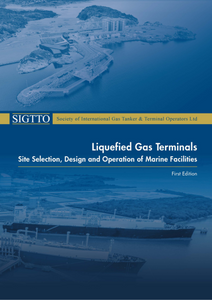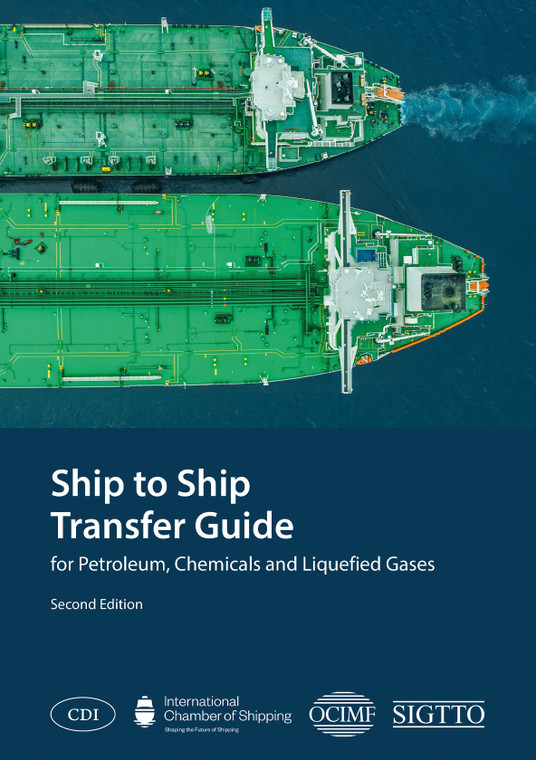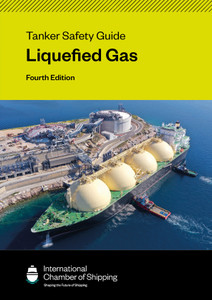
Ship to Ship Transfer Guide for Petroleum, Chemicals and Liquefied Gases - Second Edition
This cross-industry publication, developed jointly by CDI, ICS, OCIMF and SIGTTO provides comprehensive guidance on the planning and execution of Ship to Ship (STS) transfer operations for petroleum, chemical and liquefied gas cargoes. Reflecting the latest operational best practices and regulatory developments, it is applicable to all ships involved in STS activities, whether conducted at sea or in port. The Guide serves as a crucial reference for Masters, Marine Superintendents, STS service providers, and transfer organisers, ensuring safety, environmental protection, and regulator compliance.
The 'Ship to Ship Transfer Guide for Petroleum, Chemicals and Liquefied Gases' is the definitive industry reference for safe and effective STS operations, reflecting over 50 years of practical experience and regulatory alignment. Developed through collaboration between CDI, ICS, OCIMF and SIGTTO, this second edition builds upon the foundational guidance of its predecessors and incorporates significant updates to address emerging industry needs.
The second edition has been fully revised and updated and contains new guidance on:
- A dedicated chapter on human factors, emphasising the importance of human performance and decision-making in STS operations. Chapter 2 introduces the concept of alternative, emerging and innovative technology in STS operations, with guidance on evaluation, implementation, and risk management
- updated protocols for personnel transfer, including best practices derived from OCIMF's 'Transfer of Personnel by Crane Between Vessels' information paper, promoting a risk-based approach to safe transfers (Chapter 5)
- enhanced guidance on STS-specific equipment, including fenders, cargo hoses, vapour hoses and mooring equipment. This includes state-of-the-art fender-sizing calculations representing current industry best practices
- consolidated cargo operations guidelines within Chapter 10, which is divided into four distinct sections: Oil, Chemicals, LPG, and LNG. All four supporting appendices from the first edition are now seamlessly integrated into the main content, offering streamlined, comprehensive reference
- revised Ship to Ship Safety Checklists aligned with ISGOTT, reflecting best practices for procedural integrity and risk mitigation. The checklists are organised into six sections, covering the entire STS operation step by step.
The Guide also outlines key operator responsibilities, including adherence to Flag State and Port State Control requirements, maintaining liability insurance, and implementing Safety Management Systems (SMS) with best practice STS Operations Plans. Additionally, it introduces terminology updates for enhanced clarity, replacing 'Mother Ship' and 'Daughter Ship' with 'Constant Heading Ship (CHS)' and 'Manoeuvring Ship (MS).'
Intended for use by ship operators, Masters, Marine Superintendents, STS service providers, local administrations and other stakeholders, the Guide serves as a benchmark for safety and compliance during both routine and emergency STS transfers. It supports the requirements of MARPOL Annex I and is recommended to be kept on board every vessel and terminal involved in STS operations.
This edition reaffirms the industry's commitment to safe, efficient, and environmentally responsible STS operations, aligning with global maritime regulations and best practices. With its standalone structure, it provides all necessary information for safe STS operations and references authoritative industry publications, ensuring operators are fully equipped to meet modern regulatory requirements.
The checklists and forms in the Appendices, including a Ship to Ship Safety Checklist, crane plan, and LNG STS compatibility questionnaire, are available in an electronic, fillable format from the OCIMF website.
Foreword
I am very pleased to introduce the second edition of the Ship to Ship Transfer Guide for Petroleum, Chemicals and Liquefied Gases, or the STS Transfer Guide, as it is widely known throughout the global tanker industry and among the Member States of the International Maritime Organization (IMO).
It has been 50 years since the first STS Transfer Guide (Petroleum) was published. During this time, it has become recognised globally as the definitive best practice guidance on safe operational procedures for the ship to ship transfer of petroleum, chemical and liquefied gas cargoes. It is therefore an important manual for the implementation of the obligations under Annex I of the MARPOL Convention and is referenced within the Convention itself.
While this revision of the STS Transfer Guide is written to reflect current operational best practices and latest developments, I am particularly encouraged to note the inclusion of a new chapter dedicated to human factors, reinforcing that consideration of human factors is a shared responsibility for the wider maritime industry and the IMO.
Global maritime regulations, enforced by Member States, are crucial for ensuring that all ships, regardless of flag, can operate safely and efficiently, irrespective of the geographic location of the STS operation.
The authors of this Guide – the Chemical Distribution Institute (CDI), the International Chamber of Shipping (ICS), the Oil Companies International Marine Forum (OCIMF) and the Society of International Gas Tanker and Terminal Operators (SIGTTO) – consulted a wide spectrum of stakeholders to produce the STS Transfer Guide. This included STS service providers, transfer organisers, port and terminal operators and equipment providers, as well as entities involved in the development of the regulatory framework.
I recognise the value added by leveraging industry professionals' experience and I believe that publications such as the STS Transfer Guide are vital for ensuring the aims and objectives of the MARPOL Convention are achieved in practice. This edition stands as a testament to the strong relationship between industry leaders and the IMO.
It is essential that the maritime industry continues to work together to maintain and improve its excellent safety record and reduce its environmental impact. I fully support the joint effort that has gone into producing this revised edition of the STS Transfer Guide and am confident the maritime industry has the guidance needed to steer its course towards incident-free STS operations.
Arsenio Domínguez
Secretary-General
International Maritime Organization
Contents
Foreword
Introduction to the second edition
Purpose and scope
Glossary
Abbreviations
Bibliography
1 General principles
1.1 Control of operations
1.2 Risk assessments
1.3 Ship to Ship operations plan
1.4 Manning for Ship to Ship operations and the prevention of fatigue
1.5 Training and familiarisation of ship's personnel
1.6 Security
1.6.1 General
1.6.2 Threat and risk
1.6.3 Security risk assessments
1.6.4 Security plans
1.6.5 Responsibilities under the International Ship and Port Facility Security Code
1.6.6 Cyber safety and security
1.6.7 Preparation for Ship to Ship operations
1.6.8 Security on ships conducting a Ship to Ship operation alongside a terminal
2 Human factors
2.1 General
2.2 Identification and analysis of Safety Critical Tasks
2.3 Human-centred design
2.4 Procedures
2.5 Leadership
2.6 Confidence to stop work or speak up
2.7 Learning
2.7.1 Value of learning from successes and failures
2.8 Fatigue
2.9 Personnel levels
2.10 Skills to respond to emerging situations
2.10.1 Situational awareness
2.11 Communications
3 Conditions and requirements
3.1 Ship to Ship compatibility
3.1.1 General
3.1.2 Ship to Ship cargo transfer operations involving ships of a similar length
3.1.3 Use of dumb barges
3.2 Notification to and approval from authorities
3.2.1 MARPOL Annex I oil cargoes
3.2.2 MARPOL Annex II chemical cargoes
3.2.3 Other cargoes
3.3 Transfer area
3.4 Environmental conditions
3.4.1 Cold weather precautions
3.4.2 Ship to Ship operations in ice conditions
3.4.3 Cargo sloshing considerations
3.5 Quality assurance of Ship to Ship service providers
4 Managing hazards and risks for Ship to Ship operations
4.1 General
4.2 Risk assessment
4.2.1 General
4.2.2 Risk assessment of transfer location
4.2.3 Risk assessment of Ship to Ship operation
4.3 Personal Protective Equipment and lifesaving appliances
4.4 Use of checklists
4.5 Safety Data Sheets
4.6 Gas accumulation on open decks
4.7 Action in case of cargo leakage
4.8 Helicopter operations
4.9 Safety during cargo transfer
4.10 Smoking and naked lights
4.11 Earths on electrical switchboards
4.12 Machinery operations
4.13 Electrical isolation
4.13.1 Other places where electrical arcing may occur
4.14 The use of radio and satellite communication equipment
4.14.1 General
4.14.2 Automatic Identification Systems
4.15 Radar use
4.16 Readiness of firefighting equipment
4.17 Electrical storms
4.18 Unauthorised craft
5 Personnel transfers
5.1 Introduction
5.1.1 Hazard identification and risk assessment
5.2 Transfer using a Personnel Transfer Basket and ship's crane
5.2.1 Cranes
5.2.2 Personnel Transfer Basket
5.3 Responsibilities during personnel transfer
5.4 Personnel transfer by crane plan
5.5 Transfer preparations
5.5.1 Pre-transfer preparation
5.5.2 Landing/lifting area
5.5.3 Environmental conditions
5.5.4 Test transfer
5.5.5 Toolbox talk
5.6 Personnel transfer
5.7 Contingency and emergency planning
6 Communications
6.1 General communications
6.2 Language
6.3 Pre-arrival communications
6.3.1 Information required
6.3.2 Information to be provided by the Ship to Ship organisers
6.4 Navigational warnings
6.5 Communications during approach, mooring and unmooring
6.6 Communications during cargo transfer operations
6.7 Procedures in case of communication failure
7 Operational preparations
7.1 General
7.2 Joint Plan of Operations
7.3 Preparation of ships
7.4 Lightering Support Vessels
7.4.1 Recommendations for Lightering Support Vessels
7.5 Navigational signals
8 Equipment
8.1 Fenders
8.1.1 Fenders used for at sea Ship to Ship operations
8.1.2 Fender size selection procedure for Ship to Ship operations at sea
8.1.3 Number of primary fenders
8.1.4 Precautions when using fenders
8.1.5 Fenders used for in port transfers
8.1.6 Low Pressure fenders
8.1.7 Foam filled fenders
8.2 Cargo transfer hoses
8.2.1 Hose standards
8.2.2 Hose types
8.2.3 Hose length
8.2.4 Pressure ratings and flow velocities
8.2.5 Hose handling
8.2.6 Hose connection
8.2.7 Hose inspection and testing
8.2.8 Hose marking
8.3 Mooring equipment
8.4 Deck lighting
8.5 Ancillary equipment for Ship to Ship operations
8.6 Equipment noise levels
9 Manoeuvring and mooring
9.1 Basic principles
9.2 Manoeuvring alongside at sea with two ships under power
9.2.1 Recommendations for controlling the two ships
9.2.2 Advice for manoeuvring alongside
9.2.3 Manoeuvring two moored ships to the anchor position
9.2.4 Underway cargo transfer
9.3 Manoeuvring alongside a ship already at anchor
9.3.1 Ship to Ship operations with three ships
9.4 Manoeuvring for in port operations
9.5 Manoeuvring with one ship alongside a terminal
9.6 Manoeuvring with the assistance of tugs
9.6.1 Bollard Pull of tugs
9.6.2 Communication
9.7 Mooring operations
9.7.1 Mooring plans
9.7.2 Mooring analysis
9.7.3 At sea mooring operations
9.7.4 Efficiency of Ship to Ship mooring systems
9.7.5 In port double banking mooring operations
9.8 Dynamically positioning ships involved in Ship to Ship operations
10 Cargo procedures
10.1 Cargo procedures – MARPOL Annex I (Oil)
10.1.1 Responsibility for cargo operations
10.1.2 Pre-transfer procedures
10.1.3 Planning for cargo transfer
10.1.4 During cargo transfer
10.1.5 Vapour management
10.1.6 Post-cargo transfer
10.1.7 Cargo documentation and customs requirements
10.2 Cargo procedures – MARPOL Annex II (chemicals)
10.2.1 Responsibility for cargo operations
10.2.2 Pre-transfer procedures
10.2.3 Planning for cargo transfer
10.2.4 During cargo transfer
10.2.5 Handling special cargoes
10.2.6 Vapour management
10.2.7 Tank cleaning
10.2.8 Operations after completion of cargo transfer
10.3 Cargo procedures – Liquefied Petroleum Gas Carriers
10.3.1 Responsibility for cargo operations
10.3.2 Pre-transfer procedures
10.3.3 Planning for cargo transfer
10.3.4 During cargo transfer
10.3.5 Vapour management
10.3.6 Operations after completion of cargo transfer
10.3.7 Cargo documentation and customs requirements
10.4 Liquefied Natural Gas Carriers
10.4.1 Responsibility for cargo operations
10.4.2 Pre-transfer procedures
10.4.3 Planning for cargo transfer
10.4.4 During cargo transfer
10.4.5 Boil Off Gas management
10.4.6 Operations after completion of cargo transfer
10.4.7 Cargo documentation and customs requirements
11 Unmooring
11.1 Preparations for unmooring
11.2 Unmooring procedure
11.2.1 Unmooring after underway transfer
11.2.2 Unmooring while one ship is at anchor
11.2.3 Unmooring from a ship alongside a terminal
11.2.4 Unmooring using quick release arrangements
12 Emergencies
12.1 Contingency planning and emergency response procedures
12.2 Additional considerations for Liquefied Natural Gas
12.2.1 Emergency Release System
12.2.2 Emergency Release System activation location
12.2.3 Hose handling after Emergency Release Coupling release
12.2.4 Dead ship Emergency Release Coupling activation
12.3 Emergency signal
12.4 Emergency situations
12.4.1 Emergency duties
12.5 Shipboard Oil Pollution Emergency Plan, Shipboard Marine Pollution Emergency Plan
12.6 Emergency preparedness
12.7 Emergency notifications
12.8 Cessation of Ship to Ship operations
A–E Appendices
Appendix A: Ship to Ship Safety Checklist
Appendix B: Crane plan – transfer of personnel by crane between vessels
Appendix C: Fender suitability calculations
Appendix D: Hose string connection guidance
Appendix E: Example – Liquefied Natural Gas Ship to Ship compatibility questionnaire
CDI
Chemical Distribution Institute (CDI) is a non-profit and non-commercial organisation funded by the chemical industry to continuously improve the safety and quality performance of marine transportation and storage of bulk liquid chemicals. CDI manage global inspection schemes, providing consistent inspection data for the international chemical industry to use in their risk assessment processes. CDI is incorporated under the law of the Netherlands as the Stichting Chemical Distribution Institute and operates from a registered office in the United Kingdom.
ICS
The International Chamber of Shipping (ICS) is the global trade association representing national shipowners' associations from Asia, Africa, the Americas and Europe and more than 80% of the world merchant fleet. Established in 1921, ICS is concerned with all aspects of maritime affairs particularly maritime safety, environmental protection, maritime law and employment affairs. ICS enjoys consultative status with the UN International Maritime Organization (IMO) and International Labour Organization (ILO).
https://www.ics-shipping.org/about-ics/
OCIMF
The Oil Companies International Marine Forum (OCIMF) is a voluntary association of oil companies with an interest in the shipment and terminalling of crude oil, oil products, petrochemicals and gas. OCIMF focuses exclusively on preventing harm to people and the environment by promoting best practice in the design, construction and operation of tankers, barges and offshore vessels and their interfaces with terminals. Learn more: https://www.ocimf.org/about
SIGTTO
The Society of International Gas Tanker and Terminal Operators (SIGTTO) is an international body established for the exchange of technical information and experience, between members of the industry, to enhance the safety and operational reliability of gas tankers and terminals.
- Number of Pages:
- 224
- Published Date:
- September 2025
- Book Height:
- 297 mm
- Book Width:
- 210 mm
- eBook Publication Date:
- October 2025
- Weight:
- 1.2 kg
- Physical ISBN:
- 978-1-917308-73-1
- eBook ISBN:
- 978-1-917308-74-8
- Publication Date:
- September 2025
- ISBN:
- 1917308735






